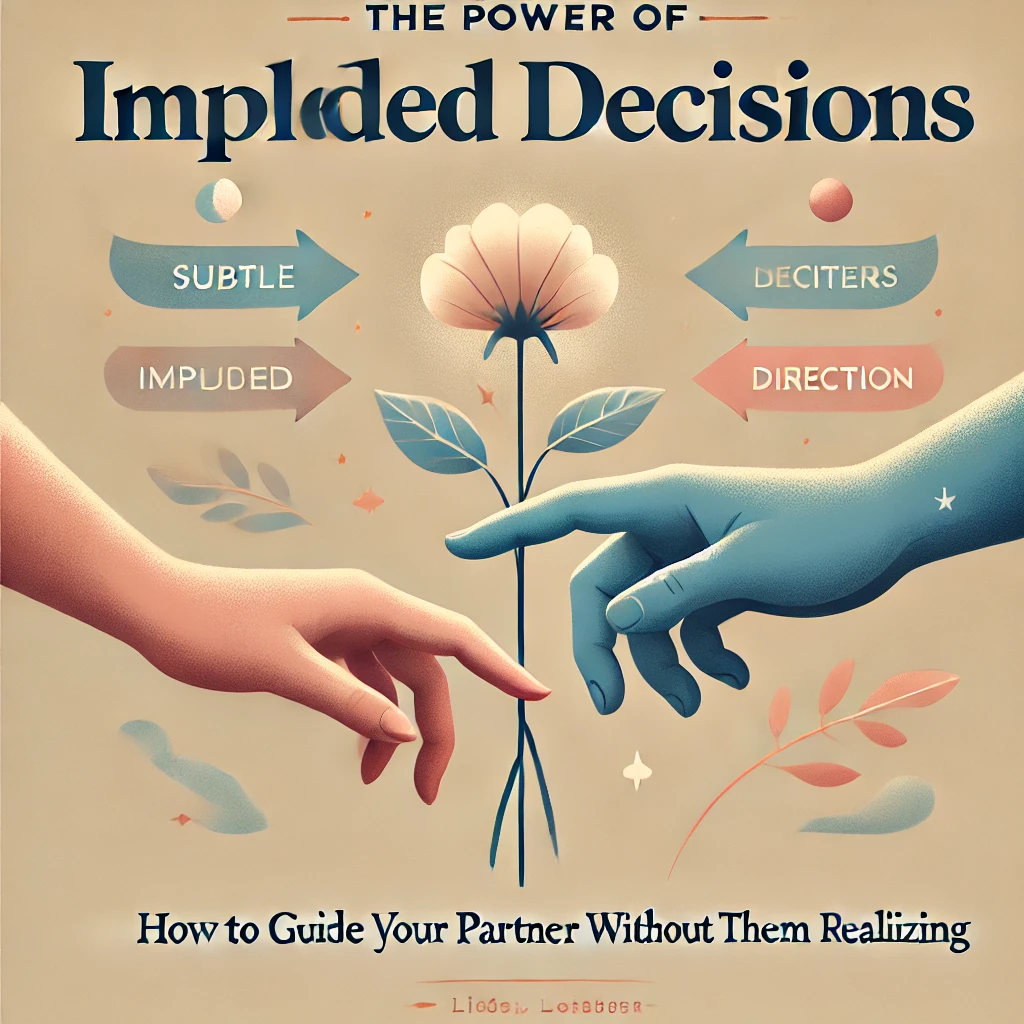In any relationship, decision-making is a shared process. But what if you could guide your partner toward decisions without ever having to make a direct request? What if you could lead them to a conclusion in such a way that they think it was their own idea all along? This is the essence of The Power of Implied Decisions—a subtle yet incredibly effective technique that lets you nudge your partner toward a choice without ever explicitly asking for it.
The Implied Decision works by framing situations in such a way that a decision feels natural and inevitable. It’s about creating a sense of flow and continuity that makes the desired outcome seem like the most logical and effortless path forward. Whether it’s about choosing a restaurant, planning a weekend activity, or even making a significant life decision, the implied decision takes the pressure off both partners by steering the conversation in a direction that leads to the outcome you want.
In this blog, we’ll dive deep into how the Power of Implied Decisions works, why it’s so effective in relationships, and give you practical, relatable examples of how you can use it to influence your partner’s choices subtly. By the end, you’ll see how this technique can help you get what you want while making your partner feel like they’re in the driver’s seat.
What Is an Implied Decision?
An Implied Decision is when you subtly steer your partner toward a specific choice without ever directly suggesting it. Instead of saying, “I think we should do this,” you frame the situation so that your preferred option becomes the easiest or most natural choice. Your partner ends up making the decision on their own—at least, that’s how it feels to them.
For example, instead of asking, “Should we stay in or go out for dinner?” you might say, “It’s so cozy in here tonight, and we have all the ingredients for that pasta we love. What do you think?” The way you frame the options subtly nudges your partner toward staying in, but it feels like a mutual choice rather than a decision you’re pushing.
Why Does the Implied Decision Work?
The Implied Decision works because it taps into the psychology of autonomy. People are much more likely to go along with an idea if they feel like they’ve made the decision themselves. By implying the desired choice instead of stating it outright, you avoid triggering any feelings of resistance or control. Your partner feels empowered, as though they’re the one driving the decision-making process, when in fact you’ve gently guided them in the direction you wanted.
It’s an incredibly effective tool in relationships because it fosters collaboration without conflict. Instead of creating a scenario where one person is asking and the other is deciding, you’re co-creating a situation where the decision feels mutual and organic.
How to Use the Power of Implied Decisions in Relationships
Let’s dive into some real-life examples of how you can use the Power of Implied Decisions to guide your partner toward choices that align with your goals while making them feel like it was their idea.
Example 1: Planning a Night In
You’ve had a long day, and all you want is a cozy night at home with your partner. But you don’t want to make it sound like you’re forcing them to stay in. Instead, you can use the implied decision technique.
How to Use an Implied Decision:
Instead of saying, “I don’t want to go out tonight,” try something like, “It’s so nice to finally relax after a busy day, don’t you think? We could light some candles, watch that movie we’ve been meaning to see, and order takeout.” The way you frame the situation makes staying in seem like the more appealing option, but it feels like a natural, shared choice.
Why It Works:
By emphasizing the comfort and relaxation of staying in, you’ve implied the decision without needing to directly ask for it. Your partner is more likely to agree because it feels like the easy and enjoyable option, and they feel involved in the decision.
Example 2: Encouraging Healthier Eating
You’ve been trying to get your partner to make healthier food choices, but you don’t want to come across as nagging or controlling. The Implied Decision can help you guide their choices in a more subtle way.
How to Use an Implied Decision:
Instead of saying, “You should eat healthier,” frame it differently: “I’ve been feeling so good lately from eating lighter meals. That grilled chicken and salad last week was so tasty and didn’t leave us feeling sluggish. How about we make something similar tonight?” You’re implying that the healthier option is more enjoyable without making a direct request.
Why It Works:
By focusing on how good the healthy meal made both of you feel, you’re implying that it’s the better choice. Your partner is more likely to agree because it’s presented as a positive, mutual experience rather than a forced change.
Example 3: Suggesting a Weekend Activity
You want to spend the weekend doing something active, like hiking, but you know your partner might be tempted to stay in and relax. Rather than presenting the options as opposites, you can use the implied decision technique.
How to Use an Implied Decision:
Instead of asking, “Do you want to go hiking or stay home?” you can say, “I heard the weather is going to be perfect this weekend, and that hiking trail we’ve been meaning to try should be beautiful with all the fall colors. What do you think?” By focusing on the appeal of the outdoor activity, you’re nudging your partner toward choosing it without making it feel like an obligation.
Why It Works:
You’ve framed the hiking trip as an exciting and timely opportunity, making it seem like the obvious choice. Your partner is more likely to go along with it because it feels like a spontaneous decision rather than a chore.
Example 4: Making a Big Purchase Together
Let’s say you’re trying to decide on a big purchase, like a new piece of furniture or upgrading your home. You have a clear idea of what you want, but you don’t want to pressure your partner into agreeing.
How to Use an Implied Decision:
Instead of saying, “I think we should buy this couch,” you can frame it as, “I’ve been thinking about how nice it would be to have more space for guests when they come over. This sectional has such great reviews, and it looks like it’s exactly what we need for the living room. What do you think?” By highlighting the benefits that matter to both of you, you imply that this specific couch is the natural choice.
Why It Works:
You’ve framed the decision around shared values and benefits, making it feel like the best option without making a direct push. Your partner is more likely to agree because it seems like a mutual decision rather than something you’re insisting on.
Example 5: Navigating Career Decisions
You and your partner are discussing future career moves, and you have a preference for what they should pursue, but you don’t want to come across as too controlling.
How to Use an Implied Decision:
Instead of saying, “I think you should take that job offer,” you can say something like, “That job offer sounds like such a great opportunity for growth, especially with the flexibility you’ve been wanting. It sounds like it could really align with where you want to go long-term. What do you think?” You’re implying that this opportunity fits their goals, but you’re not making the decision for them.
Why It Works:
You’ve connected the job offer to your partner’s long-term desires, making it feel like a logical and beneficial choice. They’re more likely to consider it seriously because it aligns with their goals, and they feel like they’re making the decision on their own.
Why the Implied Decision Works in Relationships
The Implied Decision is powerful because it allows your partner to feel like they’re in control of the decision-making process, even though you’re subtly steering them in a particular direction. It respects their autonomy while gently guiding the outcome. This technique reduces conflict and resistance because your partner feels empowered rather than pressured.
In relationships, the implied decision creates a sense of collaboration and mutual agreement. You’re not telling your partner what to do; you’re leading them to see the benefits of a certain choice, making it easier for both of you to reach a conclusion that works.
Tips for Using the Implied Decision in Your Relationship
Here are some tips to help you effectively use the Implied Decision in your relationship:
- Be Subtle: The power of the implied decision lies in its subtlety. Make sure you’re framing the decision in a way that doesn’t feel pushy or controlling.
- Highlight Benefits: Focus on the positive aspects of the decision you’re implying. By showing how the decision benefits both of you, you make it more appealing.
- Use Timing: Timing is everything. Make sure you’re introducing the implied decision at the right moment—when your partner is relaxed and open to discussion.
- Stay Open: While you’re guiding the decision, be open to your partner’s input. The key to this technique is making it feel like a joint decision, even if you’ve set the stage for it.
Q&A:
- What are implied decisions in relationships?
Implied decisions guide a partner toward a specific choice by framing the situation so that the desired option feels natural, without needing to make a direct suggestion. - How do implied decisions work in influencing a partner?
They work by subtly framing choices to make a certain outcome feel logical or appealing, letting a partner feel as if they reached the decision independently. - What are examples of using implied decisions in relationships?
Examples include framing a night in as relaxing by highlighting cozy activities or suggesting a healthier meal by focusing on how it made you feel energized. - How can I encourage my partner to make healthier choices without pressuring them?
Use implied decisions by talking about how good a recent healthy meal felt or how much energy you felt afterward, naturally guiding them toward healthier options. - Why are implied decisions effective in guiding partner choices?
Implied decisions tap into autonomy, making people more receptive to ideas when they feel the decision is theirs, reducing resistance to suggestions. - What’s the difference between an implied decision and a direct suggestion?
An implied decision gently frames an option as appealing without explicitly suggesting it, whereas a direct suggestion is more straightforward and can feel controlling. - Can implied decisions help reduce conflicts in relationships?
Yes, they reduce resistance by making decisions feel collaborative rather than dictated, allowing both partners to feel involved in the process. - How do I use implied decisions to guide our weekend plans?
Mention the appeal of activities that align with your preference subtly, like highlighting nice weather for a hike instead of directly suggesting it. - What are the benefits of using implied decisions in long-term relationships?
Implied decisions create a sense of collaboration, foster respect, and subtly influence without pressure, keeping the dynamic healthy and cooperative. - How do I use implied decisions without my partner feeling manipulated?
Be subtle and focus on shared benefits, letting them see how the choice aligns with both of your needs, making it feel like a natural conclusion.
Want to Master the Art of Subtle Influence in Your Relationship?
If you’re ready to take your influence skills to the next level and learn how to guide your partner’s decisions with ease, “Mastering Him: The Secret Art of Gentle Control in Relationships” is the guide you need. In Chapter 6, you’ll dive
deeper into the Power of Implied Decisions and discover 12 other powerful strategies to subtly influence your partner’s behavior, decisions, and emotions.
Get your copy today and start mastering the art of influence in your relationship. It’s time to gently guide your partner toward the outcomes you want—without conflict or pressure.
Read more about the book: https://developmentpill.com/mastering-him-the-secret-art-of-gentle-control-in-relationships-a-guide-to-influence-hell-never-see-coming/
Book Link: https://www.amazon.com/dp/B0DKKGLZQ9
Book Link UK: https://www.amazon.co.uk/dp/B0DKKGLZQ9
You can find book Links for other regions in this post page: https://developmentpill.com/mastering-him-the-secret-art-of-gentle-control-in-relationships-a-guide-to-influence-hell-never-see-coming/



